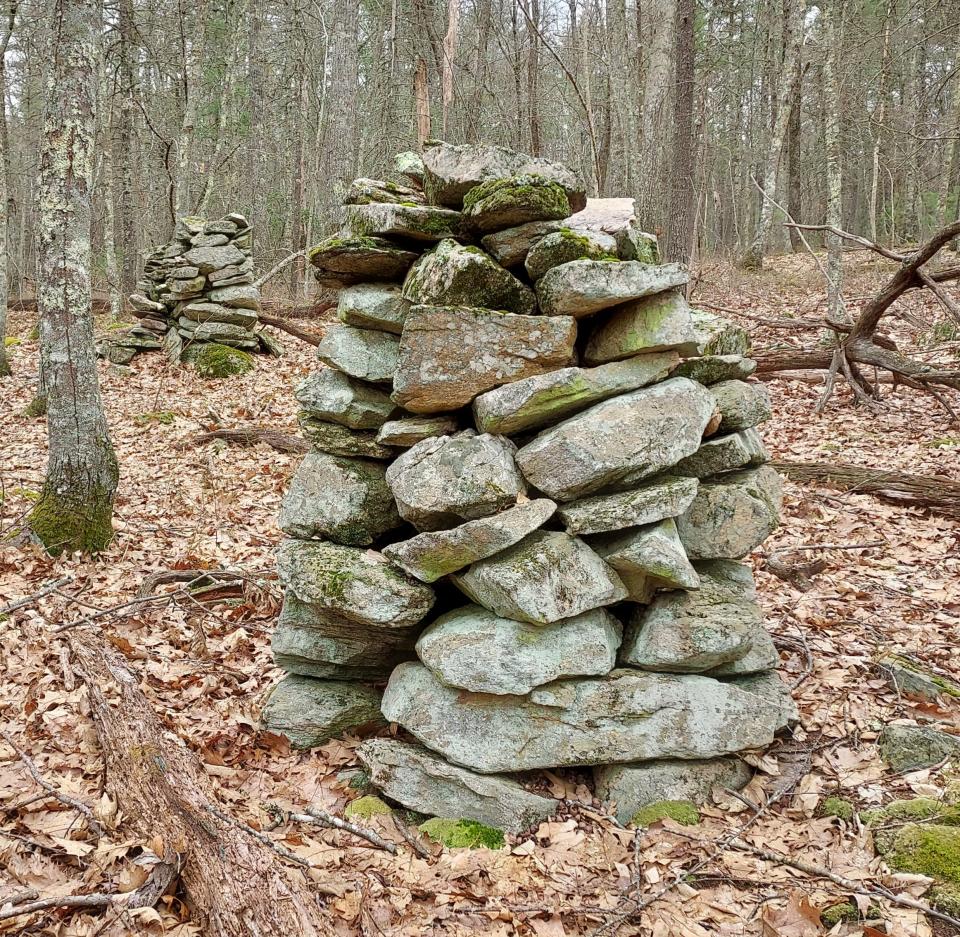What to know about ceremonial lithic stonework of southern New England and where to find it
It’s nearly impossible to walk in our region’s forests and not encounter surface rocks and stones. The Laurentide Ice Sheet, the principal glacial cover of much of North America during the Pleistocene Epoch, began to melt some 20,000 years ago. By 12,000 years ago it had receded north from our region, leaving behind massive deposits of rocks. For Indigenous Peoples who inhabited the glacier free landscape these rocks provided the materials from which they constructed sacred ceremonial stonework, symbols of spiritual reverence.
Here in the The Last Green Valley National Heritage Corridor, we see the occasional massive multi-ton erratic stone dominating its section of the woods, and long ridges of exposed granite cutting through the landscape. Yet, there is no missing the stones and rocks of all sizes laying everywhere on the ground or partly buried in the soil and forest duff. For many years I have marveled at the stone walls of farmers who used the rocks to mark boundaries and fence now abandoned fields and pasture. More recently my eyes have been opened to other stone structures in our region’s woods thanks to those dedicated to chronicling them, bringing awareness and appreciation to the beliefs and rituals of those who have lived here for thousands of years.

About ceremonial stone structures
A recent invitation from my friend, Jeff Stefanik, provided yet another example of the prevalence and importance of these structures. As both a professional surveyor and land steward for Wyndham Land Trust, Jeff spends countless hours in the woods. We hiked a mile or so along an old dirt road sloping up a hill through mature forest yet to sprout its spring blooms and greenery. The lack of vegetation brought to light the many rocks and large stones and offered a clear view through the understory. “This way,” he motioned, and I followed him off the road for several hundred feet into woods of oak, hickory, birch and maple. “There” he pointed, “can you see them now?” Standing like ancient lichen-adorned sentinels, were a half dozen or more large circular stone cairns, carefully pieced together with hundreds of flat stones. Most of them were five or more feet tall and three to four feet in diameter. Truly amazing.
Another angle on Indigenous Peoples: Why is the Killingly BOE supporting Native American group's library book grant proposal?
I have seen similar stone structures before. A few years ago, I attended a Thompson Historical Society program at a privately owned forested property which had numerous stone structures like the ones Jeff showed me. That day it was Joe Iamartino who showed us the many lithic structures, including cairns, stone heaps, stone niches, stacked stones and more. That experience led me to attend webinars about lithic structures of southern New England, and to purchase books by leading experts in ceremonial stonework, which included photographs of various types of structures and important scientific data analysis.
Curtis Hoffman is Professor of Archaeology at Bridgewater State University and has directed field operations at numerous archaeological sites in southern New England. His book “Stone Prayers: Native American Stone Constructions of the Eastern Seaboard,” published in 2018, details quantitative support for the Indigenous construction of these ancient lithic structures. The book details Hoffman’s and his team’s analysis framework used to test four hypotheses about the origins of the stone constructions. A total of 5,500 sites were documented. This quote is from the back cover of Hoffman’s book.
“Scattered throughout the woodlands and fields of the eastern seaboard of the United States and Canada are literally tens of thousands of stone monuments. These enigmatic stone constructions have been the subject of debate among archaeologists and antiquarians for the past seventy-five years. Prominent among the competing hypotheses have been allegations that all of these structures were built by colonial farmers removing rocks from their fields; or that they were built by pre-Columbian transatlantic voyagers; or that they are the result of natural deposition by glaciers or downslope erosion; or that they were constructed as sacred places by the Indigenous peoples of the region. The latter hypothesis has gained significant attention over the past decade, as the result of strong and vocal support from the regional descendant Indigenous communities for the preservation of these monuments, called by them, ‘stone prayers,’ from encroachment and desecration by development interests.”
“Stone Prayers: Native American Stone Constructions of the Eastern Seaboard,
Ceremonial stonework are reminders of area's Indigenous Peoples
Regional resident Markham Starr has documented, with photographs, 8,000 stone constructions located near his home in Stonington. His book “Ceremonial Stonework: The Enduring Native American Presence on the Land,” published in 2016, uses 270 of these images, separating these structures into 25 categories of different types and shapes of the stonework.
“While archaeological evidence shows the first peoples in New England inhabited the landscape for more than 12,000 years, newly landed colonists from Europe immediately dismissed Native American spiritual practices as pagan rituals to be destroyed or silenced through Christianization. Although disease, war and other troubles brought to the continent nearly annihilated the Indigenous population, the physical manifestations of Native beliefs, wrought in stone, were often ignored. Still standing witness to strength of their spiritual lives, the stone objects they created remain scattered across the new England landscape.”
During my walk with Jeff Stefanik, I mentioned both the Hoffman and Starr publications which he took note of, and in turn he suggested a book he was reading, “Manitou: The Sacred Landscape of New England’s Native Civilization,” by James W. Mavor Jr. and Byron E. Dix.
Published more than 30 years ago, Mavor and Dix document stone structures like those depicted by Hoffman and Starr. Of note are their descriptions of standing stones, with detailed analysis of their placement in the surrounding landscape, suggesting their role in celestial observation rituals of Native Americans.
More: Celebrate International Day of Forests by planting a tree or going for a hike
My home is located on Nipmuck land and that of their Wabbaquasset band, in a region of eastern Connecticut that both the Pequot and Mohegan also call home. I feel very fortunate to live here, within a landscape dominated by forest and fields and countless opportunities to experience the natural world.
Since I was a child, I have taken to the forest for recreation, exploration, relaxation and the renewed sense of peace nature brings. Nowadays my woods walks are enlivened with a fresh awareness, and eyes open to the possibilities of what may lie in plain sight. I walk these woods with a new appreciation and attentiveness for the ancient stonework and ceremonial traditions of the Indigenous People who have called this region their home for thousands of years.
We live in a beautiful place called The Last Green Valley National Heritage Corridor. I hope you’ll join me and many others, and together let us care for it, enjoy it, and pass it on.

Bill Reid is the chief ranger of The Last Green Valley National Heritage Corridor. He can be reached at 860-774-3300 or by email at bill@tlgv.org
This article originally appeared on The Bulletin: Ceremonial lithic stonework of southern New England Last Green Valley

